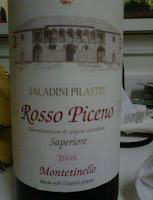This recipe is from KRXQ out of Cali. -->
Rob Arnie and Dawn- Robs Recipes
I brought this recipe with me to the East Coast and our family has been making it now for the last 6 years. The best part is the fact that it is never dry and tasteless.
I serve my turkey juicy and tender, thus it has a slight pink hue along the outer edges of each slice. I certainly cannot and am not advising you to not follow the USDA's guidelines for safely serving poultry to your family. If you, of your own free will, choose to serve your turkey as I do be ready for someone at the table to be "freaked out" by the presence of pink around their turkey. My answer to this always is, "don't eat it, then." You may want to cook your bird a little longer to avoid all of this.
Ingredients
2 Large Yellow or White Onions
1 stalk of celery
4 Large carrots
4 Large Shallots
Olive Oil
½ bunch fresh thyme
½ bunch fresh sage
½ bunch fresh rosemary
Salt and Pepper
Oh yeah... and a turkey
To Make...
1. Make sure the bird is fully thawed by placing it in the refrigerator at least 3 full days before cooking. If, on the night before, it is not thawed, place the turkey in a room temperature bath until it thaws.
2. The night before roasting, clean the turkey by removing the neck and giblets enclosed in the bird. Use them for the gravy, or discard. (See my gravy recipe for more info)
3. Rinse the raw bird completely with cold water, using your hands to "massage" the bird as it is rinsed with the water. Do this all over, and inside the bird's cavity. MAKE SURE that everything you touch is thoroughly cleansed afterwards.
4. Drizzle olive oil into the cavity of the turkey, followed by generous amounts of salt and pepper. Rub the salt and pepper all over the inside wall of the turkey.
5. Drizzle olive oil all over the turkey's breasts, legs, back, etc, rubbing the oil in. Follow it with generous amounts of salt and pepper rubbed all over the bird. The seasonings not only bring out the bird's flavors, but also help to keep the meat tender.
6. Place the bird, breast side up, in his baking pan, preferably on a rack which allows the turkey's drippings to accumulate beneath it.
7. Chop the celery, onions, carrots, peeled shallots, and herbs and mix together in a bowl.
8. Stuff the chopped herbs and vegetables into the cavity of the turkey. This is done to flavor the bird, and will not be eaten.
9. Cover the turkey and keep refrigerated over night.
10. On the day of cooking, remove the bird from the fridge in plenty of time for it to reach room temperature.
11. Preheat oven to 500 degrees.
12. Place a fresh layer of olive oil along the outside of the turkey.
13. Place turkey, legs to the back, in the oven for 30 minutes.
14. Your turkey should be beginning to turn golden brown already. (if the bird is quite large, like say 20+ pounds, you may need to add an extra 15 minutes).
15. Reduce oven heat to 300 degrees.
16. Place a triangular piece of aluminum foil over the breast and continue cooking DO NOT OPEN THE OVEN CONTINUALLY. Just let the bird cook.
17. Despite common myths, there is no formula based on "minutes per pound" to figure out when your bird will be done. In my experience, an 18 pound turkey will need another 1 ½ to 2 ½ hours of cooking at this point, but you have to use some common sense. You want you turkey's legs to reach 175 degrees, and the breast meat to reach 155 degrees. At that point, you will remove the turkey from the oven, keep it covered and carve it 10 minutes later. I suggest checking your turkey after 1 hour of cooking at 300 degrees and determining at that point how well it's going. Given the choice you'd rather your turkey be done too soon, rather than too late.
 |
| Turbo the cat, checking on the turkey. |
 |
| Finished turkey |
 |
two years later and she still wants to help around the kitchen
|




















































